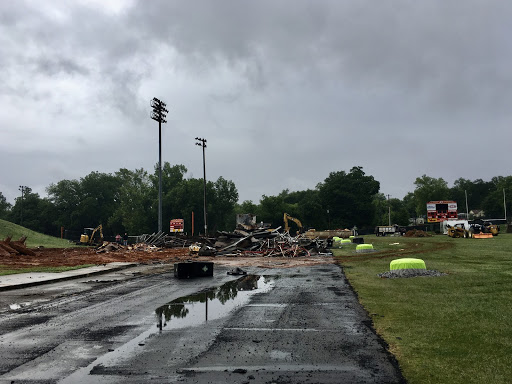Ruins of the Clarke Central High School visitor’s side bleachers lay on the unmarked Death Valley track on May 27. Renovations of the Death Valley track and field have begun and will be a much-needed upgrade, according to CCHS Athletic Director Dr. Jon Ward. “Not only do (the CCHS football and soccer teams) play on the stadium field but they also practice on the stadium field, which really wears it out, so by the end of football season and for soccer, it is a very poor playing surface,” Ward said. “And then our track, it is a very old surface, it is not good to run on. A lot of our track athletes develop injuries because of training on our track.” Photo by Emma Scott
Clarke Central High School has begun renovations on the Death Valley track and field, which will be complete in August.
After years of Clarke Central High School’s football, soccer and track and field programs using a grass field and six-lane track, construction has commenced on a new eight-lane track, turf field and visitors side bleachers.
According to CCHS Athletic Director Dr. Jon Ward, CCHS coaches, staff and community members have been discussing the renovation with the school board since the fall of the 2019-20 school year and the board was able to allocate money towards it.
“(I estimate the renovation to cost) about $4.5 million because it also involves taking down the visiting bleachers and demolishing the visiting concessions stand,” Ward said.
CCHS head track and field coach and varsity football defensive coordinator Justin Jones says that he knew that CCHS’ track needed refurbishing since he began coaching in 2016.
“When I arrived here at Clarke Central in 2016, I noticed immediately that the track needed to be either resurfaced or totally renovated,” Jones said. “It does not feel like a track, it feels more like asphalt.”
According to Ward, the track was not only uncomfortable for running on a day-to-day basis, it also had large-scale effects. Its condition made injuries more prevalent and prevented track and field athletes from being able to compete in their home stadium.
“A lot of our track athletes develop injuries because of training on our track. It is small, it is only six lanes (while) most tracks now are eight lanes” Ward said. “By it being a small track, it prohibits us from hosting region meets, invitationals, things of that nature.”
Being unable to host track and field meets meant that athletes had to travel for every competition, making fans less likely to travel to support them. Jones hopes that the updated track will generate more support for the team.
“I think that if you can have meets on your campus, (school spirit) is something that can be developed. Students do not have to travel to come to the track meet. They can actually step outside their school building and see their classmates competing and that definitely creates a culture that we would love to have here at Clarke Central,” Jones said.
“(Students) can actually step outside their school building and see their classmates competing and that definitely creates a culture that we would love to have here at Clarke Central.”
— Justin Jones,
CCHS head track and field coach and varsity football defensive coordinator
According to Ward, Death Valley’s field also needs a makeover since both the football and soccer teams practice and compete on the same field, which causes CCHS’ grass field to be quickly worn out each year. Consequently, it is being replaced by easier-to-maintain turf.
“We just put new sod down last summer and by the time soccer season began this year, the middle of the field was worn out. It’s an ongoing cycle. So the turf field is really the answer to that,” Ward said.
CCHS varsity football wide receiver Justin Hodges, a rising senior, looks forward to playing on the turf field.
“I have some complaints about playing on the grass because when it rains, the field tears so easily and becomes really muddy,” Hodges said. “I think (an artificial turf field) will be better because we will not have to worry about slipping in the mud when it rains and playing on turf you can run faster, get in and out of your stances, and really I think it can improve our game on the field.”
Despite the proposed benefits of this change, CCHS and varsity soccer defensive midfielder Aydan O’Connor, a rising senior, expects a challenging transition to the turf field.
“The ball rolls differently so it goes faster than on grass. If you have been playing on grass and then you go to turf, it can be different. And then you get cut up (when you fall on turf),” O’Connor said. “I (also) think a lot of kids are going to have to buy new turf cleats, and that can be expensive.”
Jones believes that the advantages of the new facilities will ultimately outweigh any disadvantages and attract more people to participate in and support CCHS sports.
“I hope that it gets people excited about having a nicer facility to participate in and come and watch soccer, track and field, and football there and hopefully we will build momentum,” Jones said.
